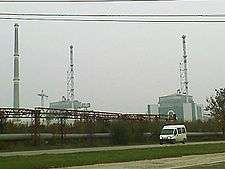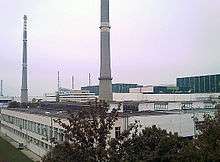Kozloduy Nuclear Power Plant
| Kozloduy Nuclear Power Plant | |
|---|---|
 | |
 Location of Kozloduy Nuclear Power Plant in Bulgaria | |
| Country | Bulgaria |
| Location | Kozloduy |
| Coordinates | 43°44′46″N 23°46′14″E / 43.74611°N 23.77056°ECoordinates: 43°44′46″N 23°46′14″E / 43.74611°N 23.77056°E |
| Status | Operational |
| Construction began | 1970 |
| Commission date |
28 October 1974 1974 (Unit 1) 1975 (Unit 2) 1980 (Unit 3) 1982 (Unit 4) 1987 (Unit 5) 1991 (Unit 6) |
| Decommission date |
2004 (Units 1 & 2) 2007 (Units 3 & 4) |
| Nuclear power station | |
| Reactor type |
VVER-440 VVER-1000 |
| Power generation | |
| Units operational | 2 x 960 MWe PWR (VVER-1000) |
| Units planned | 1 x 1,250 MWe[1] |
| Units decommissioned | 4 x 440 MWe (VVER-440) |
| Nameplate capacity | 1,920 MWe |
| Average generation | 16,314 GWh |
The Kozloduy Nuclear Power Plant is a nuclear power plant in Bulgaria situated 120 kilometres (75 mi) north of Sofia and 5 kilometres (3.1 mi) east of Kozloduy, a town on the Danube river, near the border with Romania. It is the country's only nuclear power plant and the largest in the region. The construction of the first reactor began on 6 April 1970.[2]
Kozloduy NPP currently manages 2 pressurized water reactors with a total output of 2000 MWe. Units 5 and 6, constructed in 1987 and 1991 respectively, are VVER-1000 reactors. By 2017 Unit 5 will be upgraded to reach a capacity of 1,100 MWe, as part of a programme to extend the life of the unit by 30 years.[3] A seventh 1,000 MW unit will be installed, using an assembled reactor from the terminated Belene NPP project.
The older and smaller Units 1 to 4 were all shut down by 2007.
Safety concerns and consequent shutdown of Units 1 to 4

Kozloduy NPP previously operated four older reactors of the VVER-440/230 design, but under a 1993 agreement between the European Commission and the Bulgarian government, Units 1 and 2 were taken off-line at the beginning of 2004. An unpublished 1995 report by the United States Department of Energy had supposedly listed those units among the world's "ten most dangerous reactors".[4] On 21 October 2010, licenses for the shutdown reactors were transferred to Bulgaria state radioactive waste enterprise DP RAO, signaling the formal beginning of decommissioning work.[5]
Throughout the 1990s and early 2000s Units 3 and 4, originally licensed for operation until 2011 and 2013, respectively, underwent substantial safety improvements and, after rigorous inspections, received positive reviews from the IAEA[6] in 2002, and from the World Association of Nuclear Operators (WANO) in the following year, concluding that "no technical reasons exist for the early closure of units 3 & 4".[7] Backed by these findings, the government had hoped to convince the European Commission to allow a postponement of the agreed pre-accession shutdown; from a legal and political standpoint, however, this proved untenable. Units 3 and 4 were taken out of operation in the final hours of 2006, immediately prior to the country's accession to the European Union.
82 metric tons of its spent fuel were sent to a repository in Zheleznogorsk, Krasnoyarsk Krai during 2001 and 2002.[8] In 2008, officials at the power plant announced their intention to use CONSTOR storage casks for this purpose.[9]
Prior to the shutdown of units 3 and 4, Kozloduy NPP produced 44% of Bulgaria's electricity supply; as of March 2006, Bulgaria exported about 14% of its electricity production.
Pressure to restart
In January 2009 Bulgaria's president suggested that Unit 3 be restarted in light of the gas dispute between Russia and Ukraine and resulting power shortages in the region.[10] Under the conditions of its Accession Treaty Bulgaria may request temporary derogation from its commitments in the event of serious economic difficulties arising within the first three years of membership in the union.[11]
Ownership

Kozloduy Nuclear Power Plant is a subsidiary of Bulgarian Energy Holding EAD.[12][13]
Future expansion
Bulgaria's government recently decided to start the construction of a new reactor in Kozloduy after it gave up on the construction of what was supposed to be the country's second nuclear power plant in Belene. Thus, the Bulgarian government decided to install in Kozloduy the 1000 MW reactor that the Russian state company Atomstroyexport already produced for the Belene NPP.[14] The Belene Nuclear Power Plant project was terminated in late March 2012.
In October 2013, the Ministry of Environment and Water approved the environmental impact assessment report on the investment proposal for Unit 7, thereby giving a green light for its construction.[15] A month later it was announced that construction of the reactor could begin in 2019 if full approval is granted by the Council of Ministers in 2014.[16] The Bulgarian Energy Holding (short BEH) propose to construct a Westinghouse AP1000. Negotiations between the BEH and Westinghouse already started.[17]
In 2013 the Austrian Environment Agency prepared a report on the Bulgarian Ministry for the Environment's Environmental Impact Assessment (EIA) on the proposed 7th unit of the Kozloduy Nuclear Power Plant. It assesses whether the EIA-Report allows for making reliable conclusions about the potential trans-boundary impacts on Austria. The Austrian report considers the assumption, that the Kozloduy NPP site is flood-proof, to be well-founded and the seismic hazard at the site to be low (but points out that the seismic hazard study needs updating as it was performed 20 years ago). It also highlights a number of unsubstantiated claims and some failings in the Bulgarian EIA report. These include:
- shortcomings in the safety analyses of the reactors being considered, including a lack of the consideration of post-Fukushima lessons learned and, as far as applicable, the use of the concept of practical elimination (pgs 60-61);
- serious gaps in the assessment of the impact of external human induced events such as crashes, leaks etc. (pgs 72-73);
- contrary to IAEA (2002) analysis requirements, the EIA report does not contain considerations about the formation of pressure shock waves and their possible impact on buildings of the NNU due to explosions outside the perimeter of the NPP (pg 73)
- no comprehensible technical basis provided for an evaluation of design basis accidents and severe accidents (pg 84)
- only three (insufficient) “typical” dry case weather conditions were used for the calculations of the trans-boundary impacts on the Austrian territory, not worse case scenarios.[18]
References
- ↑ Bulgaria quits Belene Nuclear Power Plant project, Novinite, 28 March 2012
- ↑ "Kozloduy NPP Plc - History". Web page o Kozloduy Nuclear Power Plant. Retrieved 2011-03-16.
- ↑ "Russia contracted to upgrade Bulgarian reactors". Nuclear Engineering International. 22 October 2015. Retrieved 27 October 2015.
- ↑ Broad, William J. (1995-07-23). "U.S. Lists 10 Soviet-Built Nuclear Reactors as High Risk". The New York Times. Retrieved 2009-01-07.
- ↑ "All change at shut-down Bulgarian reactors". World Nuclear News. 2010-10-21. Retrieved 2010-10-27.
- ↑ "IAEA Experts Review Safety of Kozloduy Units 3 and 4". IAEA. 2002-07-09. Retrieved 2009-01-08.
- ↑ "Nuclear Power in Bulgaria". World Nuclear Association. 2008-12-01. Retrieved 2009-01-08.
- ↑ National Research Council (U.S.). Committee on the Scientific Aspects of an International Spent Nuclear Fuel Storage Facility in Russia, Glenn E. Schweitzer, A. Chelsea Sharber, et. al (2005). An international spent nuclear fuel storage facility: exploring a Russian site as a prototype : proceedings of an international workshop. National Academies Press. pp. 145, 146. ISBN 978-0-309-09688-1.
- ↑ "The English Language Bulletin of Kozloduy Nuclear Power Plant" (PDF). Kozloduy Nuclear Power Plant Official Bulletin. 2008. Retrieved 2010-10-09.
- ↑ "Bulgaria urges return to nuclear". BBC. 2009-01-06. Retrieved 2009-01-07.
- ↑ "Act concerning the conditions of accession of the Republic of Bulgaria and Romania and the adjustments to the Treaties on which the European Union is founded". Official Journal of the European Union. 2005-06-01. Retrieved 2009-01-07.
- ↑ "Bulgaria Consolidates Five Energy Companies into Holding". Sofia News Agency. 2008-02-13. Retrieved 2008-02-24.
- ↑ "Bulgaria announces birth of energy giant with new holding company". Power Engineering. 2008-02-14. Retrieved 2008-02-24.
- ↑
- ↑ "Bulgaria's Environment Ministry OKs EIA Report on Unit 7 of Kozloduy NPP". Novinite. 3 October 2013. Retrieved 3 October 2013.
- ↑ http://banks.dir.bg/2013/11/21/news15568778.html
- ↑ http://sofiaglobe.com/2013/12/11/bulgaria-to-begin-talks-with-westinghouse-on-new-kozloduy-nuclear-reactor/
- ↑ "Kozloduy NPP – Construction of unit 7: Expert Statement to the Environmental Impact Assessment Report" Andrea Wallner, Helmut Hirsch Adhipati Y. Indradiningrat, Oda Becker, Mathias Brettner, Environment Agency Austria, 2013
External links
| Wikimedia Commons has media related to Kozloduy Nuclear Power Plant. |
- Kozloduy Nuclear Power Plant homepage
- Bulgaria's Nuclear Regulatory Agency
- IAEA's Bulgaria links
- Article with diagrams